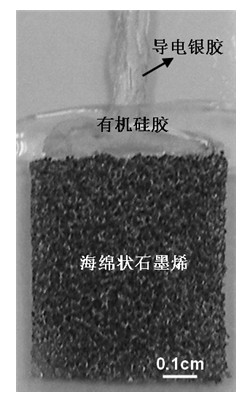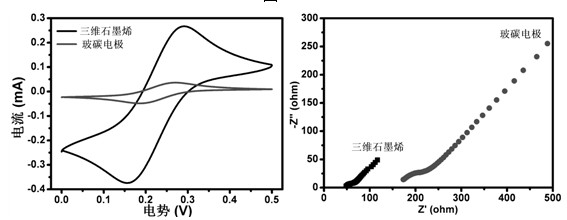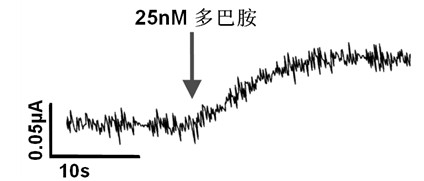Preparation method and application of three-dimensional graphene electrode for electrochemical biosensor
A graphene electrode and biosensing technology, applied in scientific instruments, material analysis through electromagnetic means, measuring devices, etc., can solve the problem of difficult to effectively utilize the specific surface area and high conductivity of graphene, functional modification and low specific surface area , poor conductivity of glassy carbon electrodes, etc., to achieve the effect of easy to realize large-scale preparation, low price, and good electrochemical stability
- Summary
- Abstract
- Description
- Claims
- Application Information
AI Technical Summary
Problems solved by technology
Method used
Image
Examples
Embodiment 1
[0028] The three-dimensional structure spongy graphene sheet synthesized by chemical vapor deposition is fixed on the surface of the glass sheet with 0.2mL of organic silica gel with a concentration of 48g / L;
[0029] Use 0.2mg of conductive silver glue to connect the three-dimensional graphene to one end of the metal wire at 20°C, and the bonding time is 5 minutes;
[0030] Apply 20mg of organic silica gel to the connection point between the metal wire and graphene for insulation, and the curing time is 5 hours to form a non-functional three-dimensional sponge-like graphene electrode;
[0031] The three-dimensional sponge-like graphene sheet is a square with a side length of 0.5 cm.
[0032] The metal wire material is titanium.
[0033] figure 1 Optical photographs of the three-dimensional sponge-like graphene electrodes prepared for the above method; figure 2 Comparison of the cyclic voltammetry curves and impedance of the three-dimensional sponge-like graphene electro...
Embodiment 2
[0035] The three-dimensional structure spongy graphene sheet synthesized by chemical vapor deposition is fixed on the surface of the quartz sheet with 0.2mL of organic silica gel with a concentration of 48g / L;
[0036] Use 0.3mg of conductive silver glue to connect the three-dimensional graphene to one end of the metal wire at 25°C, and the bonding time is 10 minutes;
[0037] Apply 35 mg of organic silica gel to the connection point between the metal wire and the graphene for insulation, and the curing time is 12 hours to form a non-functional three-dimensional sponge-like graphene electrode.
[0038] The three-dimensional structure sponge-like graphene sheet is a circular sheet with a diameter of 2 cm.
[0039] The metal wire is made of copper.
[0040] image 3 Time-current maps of dopamine detection for the non-functionalized 3D sponge-like graphene pole described above.
Embodiment 3
[0042] The three-dimensional structure spongy graphene sheet synthesized by chemical vapor deposition is fixed on the surface of the quartz sheet with 0.2mL of organic silica gel with a concentration of 48g / L;
[0043] Use 0.3mg of conductive silver glue to connect the three-dimensional graphene to one end of the metal wire at 25°C, and the bonding time is 10 minutes;
[0044] Apply 50 mg of organic silica gel to the connection point between the metal wire and graphene for insulation, and the curing time is 12 hours to form a non-functional three-dimensional sponge-like graphene electrode.
[0045] The three-dimensional structure sponge-like graphene sheet is a square with a side length of 0.5 cm.
[0046] The metal wire material is silver.
[0047] Figure 4 Electrochemical cyclic voltammetry curves for the simultaneous detection of dopamine and uric acid for the above non-functionalized 3D sponge-like graphene pole.
PUM
 Login to View More
Login to View More Abstract
Description
Claims
Application Information
 Login to View More
Login to View More - R&D
- Intellectual Property
- Life Sciences
- Materials
- Tech Scout
- Unparalleled Data Quality
- Higher Quality Content
- 60% Fewer Hallucinations
Browse by: Latest US Patents, China's latest patents, Technical Efficacy Thesaurus, Application Domain, Technology Topic, Popular Technical Reports.
© 2025 PatSnap. All rights reserved.Legal|Privacy policy|Modern Slavery Act Transparency Statement|Sitemap|About US| Contact US: help@patsnap.com



